You’ve conquered dungeons and the local village, and now you want to have your players explore a huge, fantasy city. You poor, delusional fool! Okay, we’ll help.
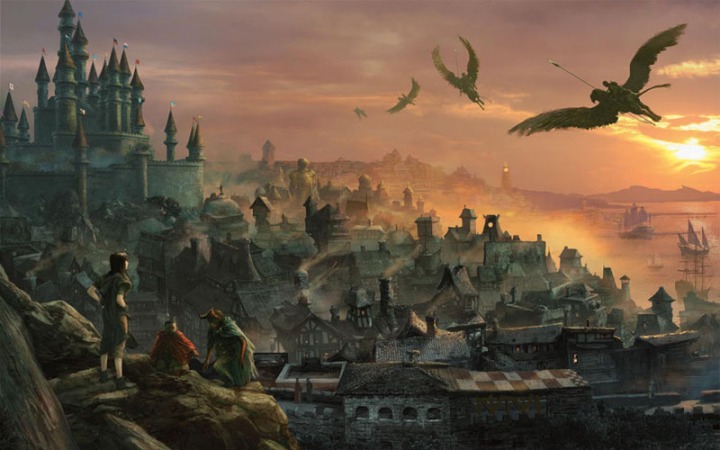
You’ve been running a D&D campaign for some time now and your players have become small town heroes. But eventually, they will want more. They will point to the biggest dot on your fantasy map and ask, “What’s that?” And you will say, “That is Such-and-Such. She is the crown jewel and the capital city of So-and-So, the largest city in the land.” Your players will immediately want to go there and you will say, “Oh yeah, let’s do this.” And then you will think, “Oh no, what have I done?”
Greyhawk, Lankhmar, Thyatis, Minas Tirith, Sharn; in every role-playing world and fantasy setting there is one city that is the grandest of all. The cosmopolitan melding of medieval and modern, where magic and civil planning collide. The allure of running such a huge melting pot of plot hooks and side quests and quirky NPCs and character driven story arcs is irresistible. But how do you keep so many elements and variables from becoming just a jumbled mess that is never as grand as you hoped or as fun as it should be?
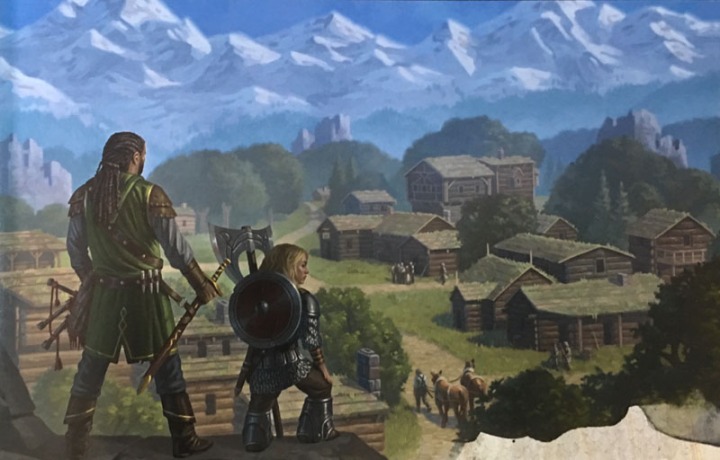
There are a number of sites that discuss how to create your own fantasy city. They delve into a lot of numbers; how many districts does it have, how many people, shops, taverns, and guilds? And so on. This is not that post.
This post is about how you manage all that information. How do you present an urban sandbox environment that feels vibrant and alive but does not overwhelm you or the players? And how do you keep the city fresh and unique, so that you don’t end up with General Goods Store #5 and 27 guards named Bob?

In my current campaign, we are playing a conglomeration of Waterdeep: Dragon Heist and Tales of the Yawning Portal which are both based around the enormous city of Waterdeep, in the Forgotten Realms campaign setting. All of my advice here is specific to that setting but it can be applied to any setting, even your own home brewed one. So, without further ado, may I present Waterdeep, the City of Splendors!
The Accessories
To start with, the main module, Waterdeep: Dragon Heist, has an entire section devoted to exploring Faerun’s favorite city. Starting on page 163, Volo’s Waterdeep Enchiridion is a great resource for both you and the players. I would print of a copy for them (it’s 26 pages) and have Volo give them a copy, signed of course, as part of the reward for rescuing Floon in Chapter 1.
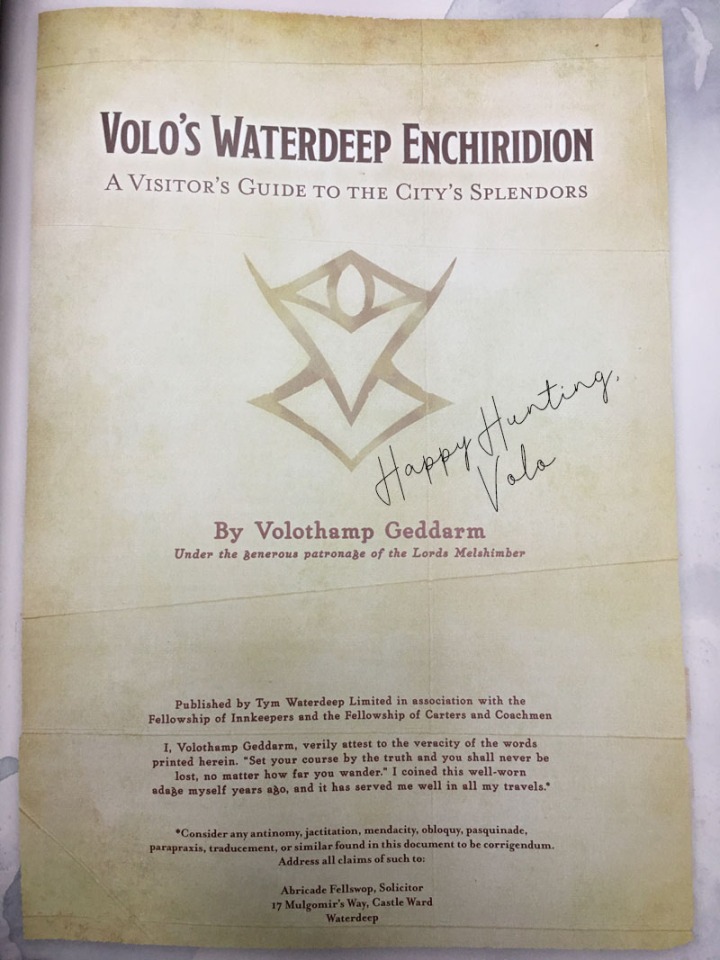
This Enchiridion does a great job describing the different wards (districts) within the city. It also has great details about the local holidays (see The Calendar, below). It also gives a brief history of the city, discusses its money, its amenities, getting around, and the legal system. I would also print out a copy of the Code Legal from the back of the book, because if your group is anything like my pack of murder hobos, they will definitely run afoul of the law at some point. In fact, one of my side quests guarantees this.

While the adventure is excellent and the Enchiridion is useful, the book does not do a good job of presenting the vast breadth of the city. The entire town is reduced to one city block with a few scattered buildings and set pieces with nothing in between. The whole thing seems like a hodgepodge dungeon crawl; the solitary Inn is connected to a warehouse, then a sewer hideout, to a random alley, a temple, a noble villa, and so on.
We need to have more of everything to flesh out our city and make it come alive. I realize that the authors leave it up to the DMs to flesh out the city, but who has the time. Plus, I want my players to be part of the official world as it is presented in decades worth of adventures and accessories.
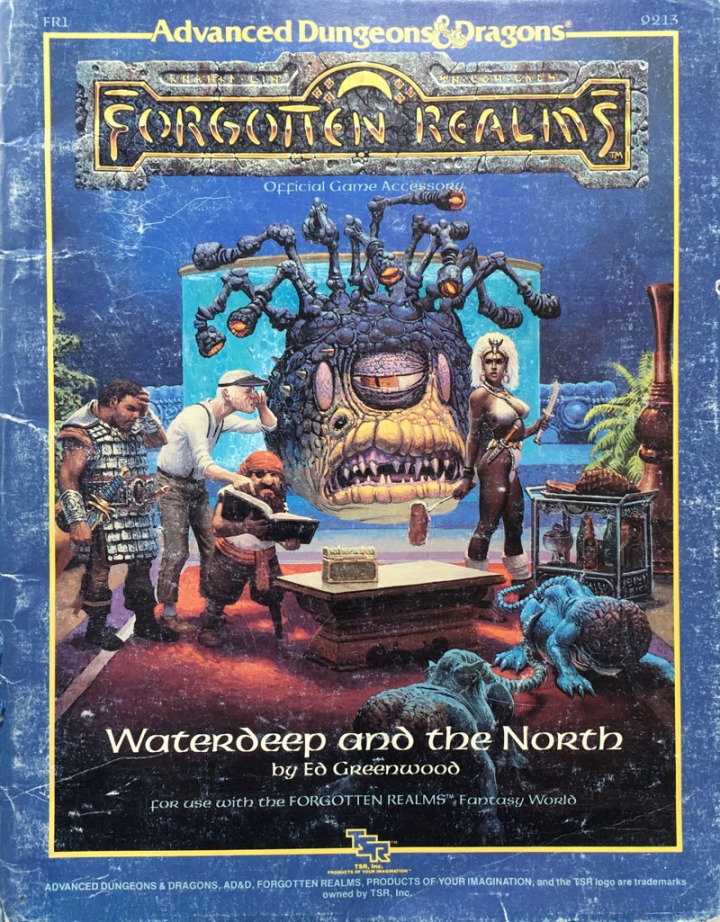
I use two accessories to do that. The first and best is the original First edition accessory, FR1 Waterdeep and the North. If I were to buy just one supplement it would be this one. This booklet is packed to the gills with information specific to The City of Splendors and it has the best print map of the city.
The booklet details over 280 unique locations, including taverns, stores, guildhalls, temples, noble houses, and government offices. There are dozens of NPCs with stats, backstories, and descriptions. The book also does a good job of explaining the power struggle between the three main factions within the city; the nobility, the guild masters, and the ruling class, which consists of anonymous “Masked Lords” who come from all walks of life and whose identities are kept secret to avoid corruption.

The second book, Volo’s Guide to Waterdeep, is an absolutely terrific read. It delves deeply into the lore and flavor of every inn, tavern, shop, and feast hall in Waterdeep. It also captures the flavor and vibe of the diverse districts that make up the city, from the quiet opulence of the noble Sea Ward to the noise and squalor of Dock Ward. Hundreds of NPCs are given full description, but the book is more about story and less about stats, so it is great for any campaign set in any era. There are several other books and products about Waterdeep and if you cannot get either one above, then get whatever you can.
If you really cannot get any other accessory to guide you through the city, you can do the work yourself. Use the Directory (see below) as a starting point. Fill in the Directory with names of the owners of the shops and taverns and create your own descriptions on the various places. You will need to find details about the nobles and the other places of interest, like Blackstaff’s Tower or Mirt’s Mansion but a lot of this info is available on the Forgotten Realms Wiki.
The Map
As with any good dungeon, it all starts with a good map. And, of course, size does matter. To truly capture the grandeur of such a glorious city the map should be a minimum of 22” x 34”. When you unfurl this map, it will require all your players to move their stuff to make room and says, “This place is so massive that even the map will toss dice and PC sheets aside.”
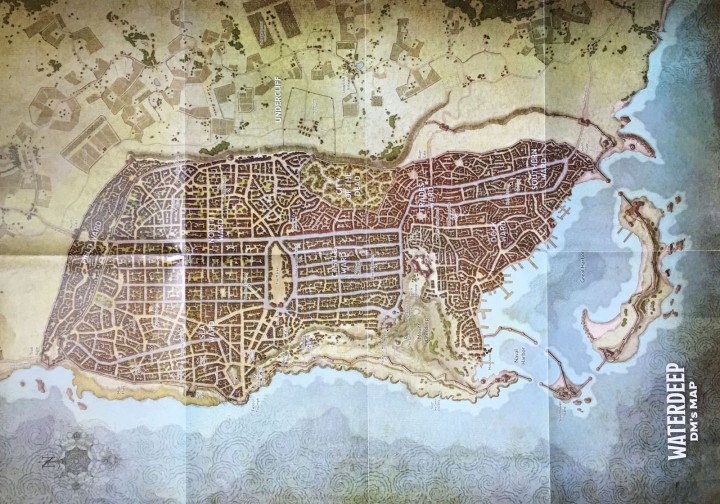
This size allows the map to display all the street names and locations so that the players can find their own way around the city. This isn’t a dungeon with the requisite fog of war. If you need to hide something from the players, just don’t mark it on the map until they find it. It also gives the players a sense of accomplishment when they find something.
When my players first entered the city of Waterdeep, they were exhausted from battling a handful of trolls at the gate. The players asked where the best inn was. A random NPC said to go to Gondalim’s at the corner of Waterdeep Way and Burnt Wagon Way. Whether this is the “best” inn is debatable, but it definitely took the group several minutes to find it on the map, and they had fun doing it.
I never give the number of the building; I always refer to them by street names or another recognizable feature on the map. Or I give them a set of directions, and then it is up to the players to scour the map, looking for it, just like real life before the days of GPS. One caveat; you can’t do this all the time. It will get old quick. I only do it when the party has to look for something; otherwise I just point it out.

I use the map that comes with the aforementioned accessories. It is great. It is large and it has about 300 locations marked on it, and it is printed on paper, so I can write on it.
However, that map has gone through a few changes from when it was printed 25 years ago to today. The major change is the expansion of the city to include three new districts. But the one the players will most encounter are the giant statues throughout the city. This involved a storyline where these statues came to life wreaking havoc until they were stopped and froze where they stood, some in awkward positions. I love this detail, so I drew the statue locations right onto my map.
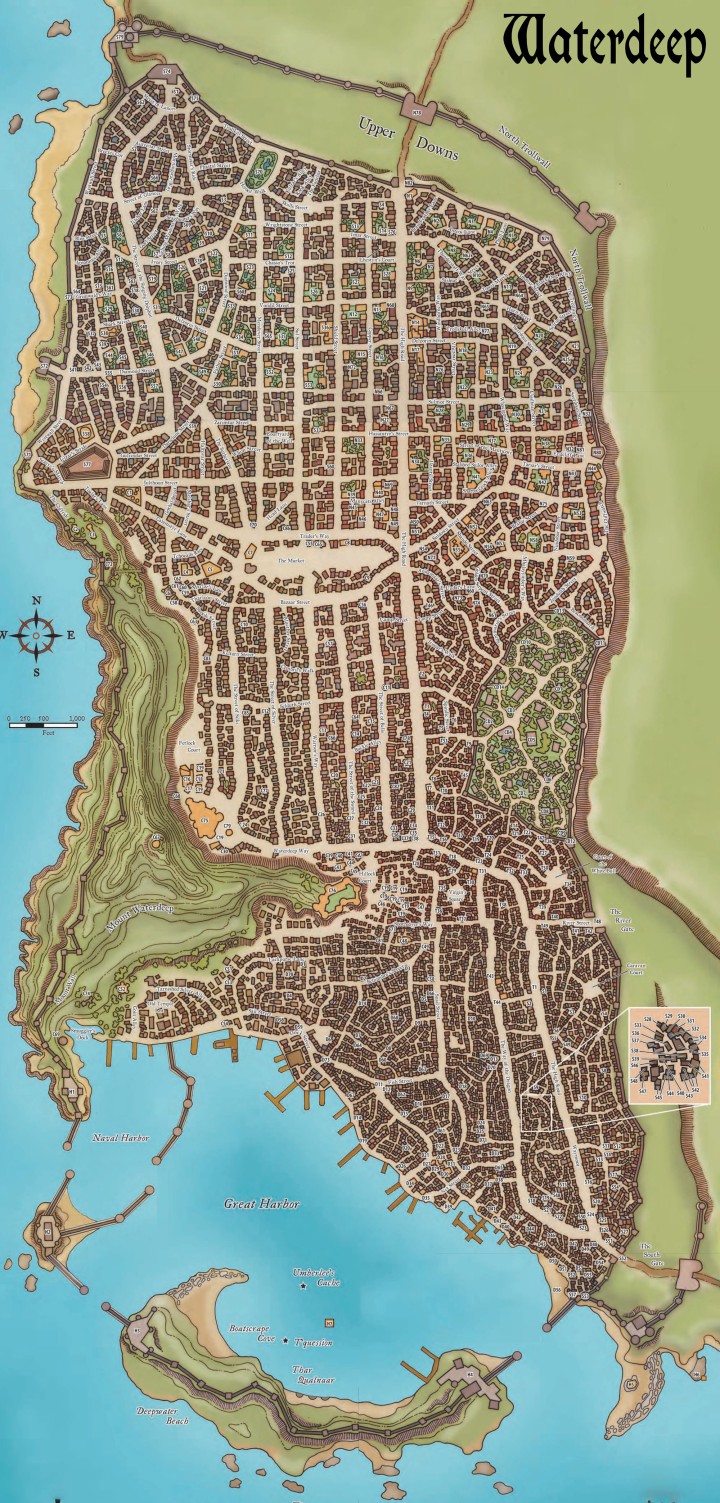
If you are playing D&D digitally, the best free online map I’ve found is the Waterdeep Interactive Map. It has location markers for over 300 locations. I also know that the map that is available from Fantasy Grounds is really good, but I’ve never used it personally. I am working on a hand-drawn 5-foot Battle Mat for the entire city. If I ever complete it I will upload it.
The City
The FR1 Accessory for Waterdeep lists over 35 taverns, 30 shops, 25 inns and hundreds of houses, guilds, and other landmarks. Of course, this is overkill and is a mess to deal with, but it certainly doesn’t lack for places to go and things to do.
To keep everything manageable, I printed up a directory of all of the locations that any resident would likely visit or be aware of. It’s basically a phone book with addresses and a very brief description of the place, separated into categories, like shops, taverns, and landmarks. My directory for Waterdeep includes the locations from the FR1 accessory and Dragon Heist. A PDF of my directory is here: Waterdeep Directory

Now the players can tell me wherever they want to go without having to ask me what all of their options are. If they want to go to the weapon smith there are four they can choose from. If they want a tavern, will they pick the “cozy & local” or the “dark and mysterious”? Plus, each address is really just the map’s location number. I even slipped in a mention of the tavern that they obtain during the adventure and the players loved it when they saw that their place was listed in the directory.
One of my players was really engaged with this handout and probably at least one of yours will be too. He uses it every session. Whenever I mention a place, he immediately looks it up and is thrilled when he finds it and learns its address. For him, this makes him feel that Waterdeep is a real place with things that exist outside of his group, which is exactly what we want as DMs.
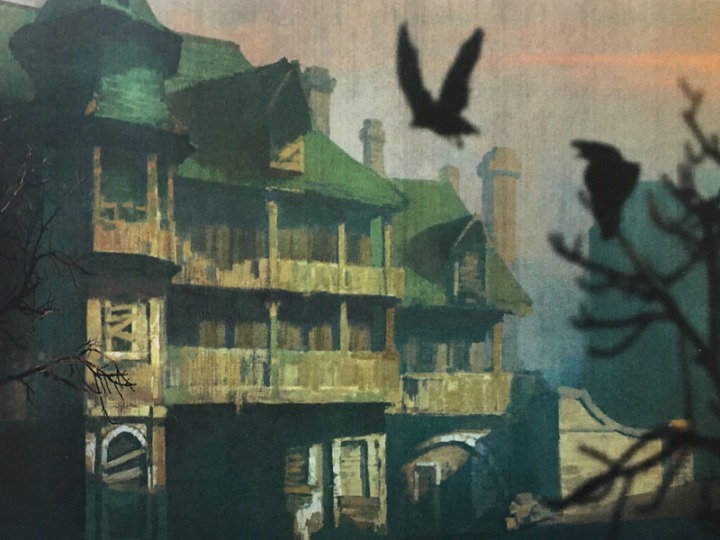
You will notice that my directory doesn’t list any private homes or noble villas. This will require that the players will still need to find some things on their own. But on the flip side, there are a few extra places added in, like The Blue Alley or the haunted Dragon Tower that might pique their interest and lead to good side quests.
I also put this Directory to good use during the part of the adventure when they are tracking the movements of a missing person in Chapter 1. The adventure as written has the party visit one tavern and immediately learns the victim’s location. But there are over a dozen taverns in the area.
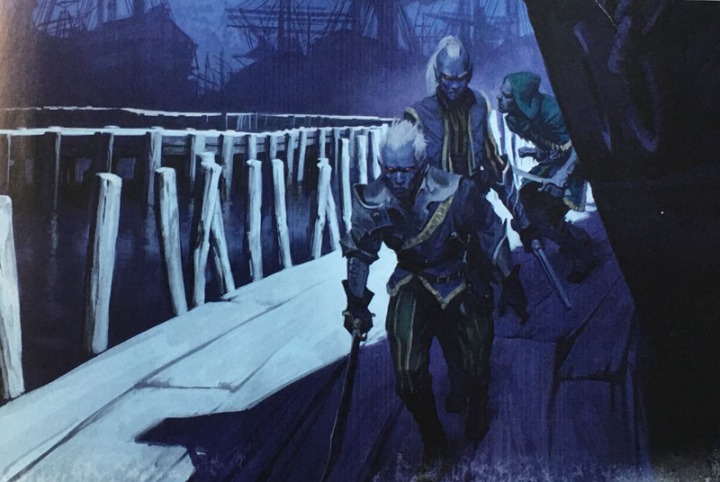
So, I sent them on a wild goose chase through the Dock Ward. They went to nightclubs, a curio shop, a perfumery, and several bars that got dirtier and seedier as they went. Each time, I would give them simple directives/clues that were dropped by NPCs, “He left here and went north up the street”, or “He said he was going to the Thirsty something-or-other”. Then using the map and the directory, the players had to figure out where he went.
There are other ways to use this to have your players explore the city. You can send them on a scavenger hunt, “Get me a mug from every tavern with an animal in its name.” Or a progressive treasure hunt, “Your first clue lies silent in the House of Song (the library in the musician’s guildhall).” It can be very effective.
The People
Waterdeep is home to 100,000 people, all living their meager little lives until the player characters show up to give them some meaning. Fortunately, you only need to keep track of about 100. Maybe 150. But they need to be fleshed out NPCs, with names, occupations, defining motivations, and identifiable characteristic. Otherwise you will end up with Shopkeep #5 and 27 guards named Bob.
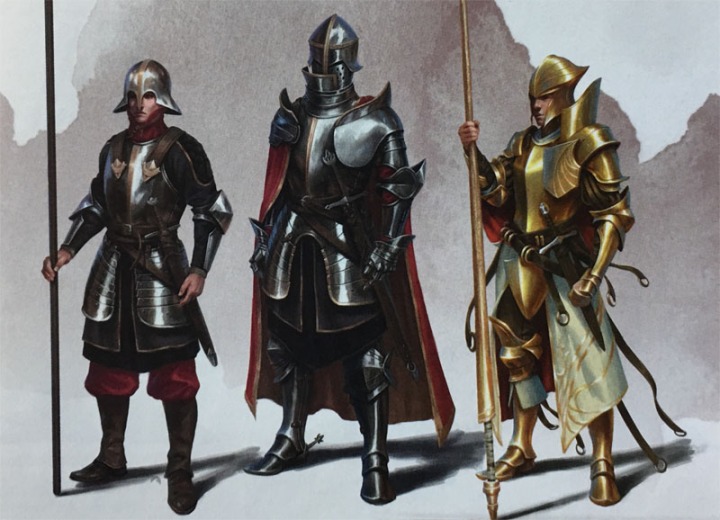
Coincidentally, the two accessories list over 150 NPC within their pages. But now the problem is keeping track of them.
I have an excel sheet that has all of these NPCs on it. This includes their name, appearance, main location, alignment, and a simple stat such as Fighter 3 or Commoner just in case the PC goes murder hobo on the poor guy. I also include their main character trait or mannerism. Often, I write down a character from a movie that I will use that to portray the NPC and make him unique.
For example, my party recently met two very different mages that will come back into play when they return from their current dungeon crawl. The first is the Blackstaff of Waterdeep (one of the leaders of the city) who I play as Obi-Wan Kenobi, exceedingly wise and measured in his speech. He is clearly the smartest one in the room and is always willing to share his knowledge, yet manages to never share too much. For the other, I wrote J. Jonah Jameson, who is the nemesis of Spiderman. He is a bullying, narcissistic fool with power. This makes role-playing these NPCs much easier for me, especially when I have to improvise.

The other aid that I use for all these NPCs is a hard copy list of generic names. Even with a comprehensive list of 200 NPCs, your players will always ask for the name of that random guard, or the serving girl, or the clerk, and on and on. Having such a list will help you create a living world on the fly. Later, you can add him to the official list and make him a recurring character. Xanathar’s Guide to Everything has excellent lists of names for every race in the game, but there are countless others online for different eras, nationalities, and languages.
The Calendar
Most fantasy realms have a unique calendar system and the Forgotten Realms is no different. Basically, there are 12 months of 30 days each, and there are five holiday festivals that coincide with the seasons and exist between appropriate months. This equals 365 days and every 4 years they add a special extra festival day to commemorate it.
Waterdeep: Dragon Heist is a distinctly seasonal adventure. Not only do you choose the main villain but also the season in which the adventure occurs. This notion of time passing regardless of the players’ actions is an incredible way to lend verisimilitude to your world, making it seem more real.
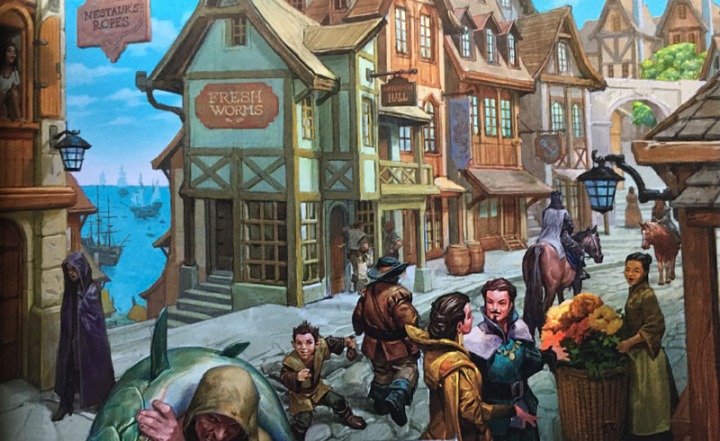
Plus, Waterdeep has some interesting holidays, unique to that city. The Dragon Heist adventure does an excellent job depicting these various holidays, so use them whenever you can. Recently, my group attended a noble party. Rather than have it occur on any random day, it occurred during Trolltide, a holiday commemorating the city’s victory over the Troll Horde hundreds of years ago.
Trolls have become a recurring theme in this adventure. Since arriving in Waterdeep, my players have been exposed to how trolls have affected the city on numerous occasions. They defeated a group of trolls when entering the city for the first time, thus earning them the nickname, The Defenders of Trollgate. I’ve mentioned the Trolltide holiday several times. When they visited the Heroes’ Garden, they saw a statue depicting several venerated heroes of that infamous Troll War. This all creates a richer world for the players and when they inevitably save the city from another Troll Invasion, it will bring the whole story full circle.

To further flesh out where and when to have pivotal moments occur, I created a Faerun Calendar. I use it like a regular calendar except instead of making notes like “Dentist Appointment” or “Surprise Party”; I have important DM events, like “Start Forge of Fury” or “Goblin Invasion”. And that special holiday that occurs once every four years, Shieldmeet? I guarantee that something momentous will occur on that day. Here is a clean copy of my calendar for all your “special” moments. Faerun Calendar
The Newspaper
Like any good cosmopolitan city, Waterdeep has an established news agency. In fact, they have two. I prefer to use the Waterdeep Wazoo, since it is far less interested in reporting facts. If you have the time and the energy, creating a single page “Broadsheet” is an incredible way to immerse your players into life in the big city.
For my “articles”, I would include things that the party has done, mixed in with various bits of foreshadowing, potential story hooks, and lots of rumors, both true and false. If you are having trouble coming up with random stories, the original Forgotten Realms Campaign Guide (DM Sourcebook) has an entire section devoted to rumors and legends that you can modify to your setting.
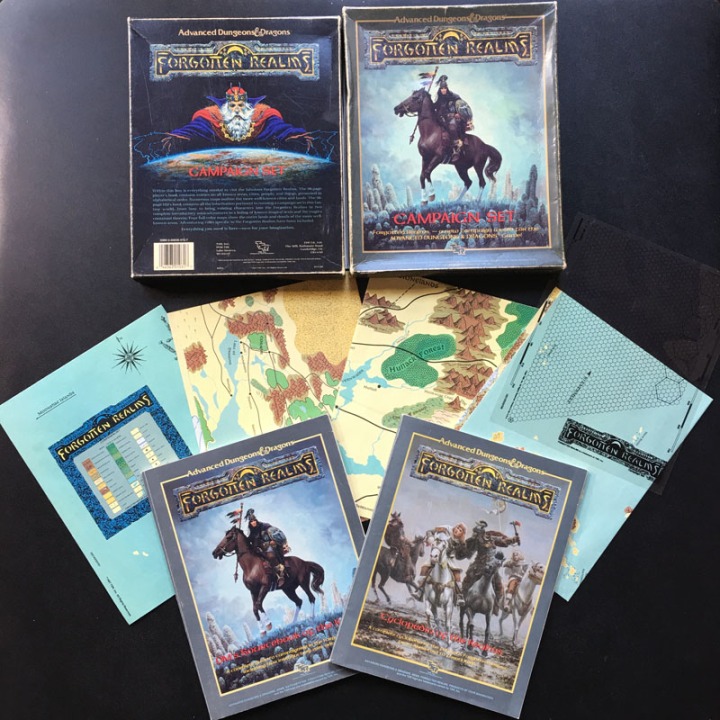
In the first paper I handed to my players, the headline was about a massive incursion of trolls at one of the gates that was repelled by unknown strangers (the party). I also included stories about the gang war waging between the Zhentarim and the Xanathar, that resulted in dozens of dead bodies at a warehouse whom appeared to be murdered by a third group (the party); and a bit of excitement at the Yawning Portal when a monster climbed up from the dungeon below wreaking havoc until it was destroyed by unknown adventures (the party).
But these were buried amongst other articles, including an advertisement for The Sea Maiden’s Faire which will arrive in time for the Mid-Summer Festival (which is of course marked on my calendar), a report of a stolen artifact (Whelm) from a local temple (foreshadowing White Plume Mountain), an anonymous editorial about how the Masked Lords are just puppets for the Blackstaff, and help wanted ads.

All of these things reflect the various stories I have interwoven around this campaign and help create a world that is more than just these four players, while still making them front and center. These stories also remind the players about plot points that the players missed the first time around. The article about the Trolls at Trollgate reminded them that there was a bigger story for them to investigate. I’ve included a PDF copy of the paper for you to steal completely, or use the format for your own stories. Waterdeep Wazoo
The Adventure
How do you incorporate all of these elements into a cohesive world for your players to explore and yet keep you sane? If you have followed all of the above (or just downloaded them from this site) then you have 6 extra pieces of information:
- A good accessory guide (or 2)
- A large map
- A directory of major buildings Waterdeep Directory
- A list of NPCs (and a list of just names)
- A land-specific calendar Faerun Calendar
- A gossipy newspaper Waterdeep Wazoo
With these things you can basically treat a major city like a dungeon with a few modifications. When running a dungeon, you basically control two elements: Getting around & Encounters.
In a dungeon, moving from room to room is very methodical, and each room has a description of what you see as you enter it. But when travelling through a city, it usually breaks down to “You leave the inn, and twenty minutes later, arrive at your destination.” This is a mistake. Describe the journey to wherever, just keep it brief.
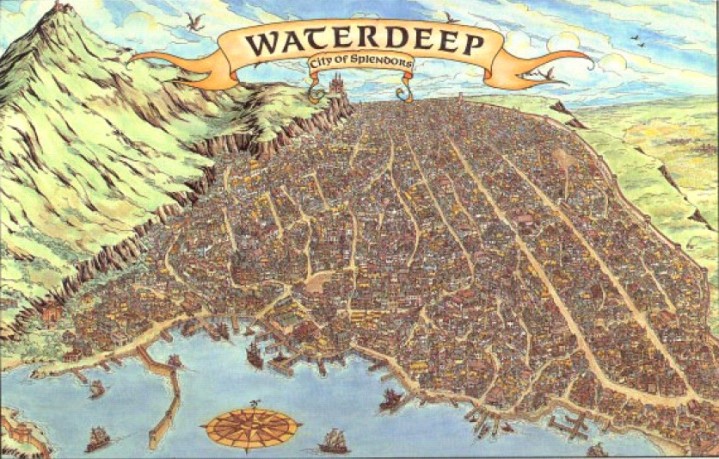
Using the map, find the major places of interest between the start and end points. Put together a quick list of things to describe during the trip. If the party happens to travel between wards (districts) have a few lines of description to accentuate that change to give each area its own flavor. And if you decide to have a random encounter, place it at a specific location, like an intersection or in front of a named building.
For example, let’s say that the party is travelling from the Yawning Portal Inn to the God Catcher, one of the famous Walking Statues and the site of one of my side quests, here is how I would describe the trip. At the end of each paragraph, pause to see if the players want to investigate further anything you’ve just read.
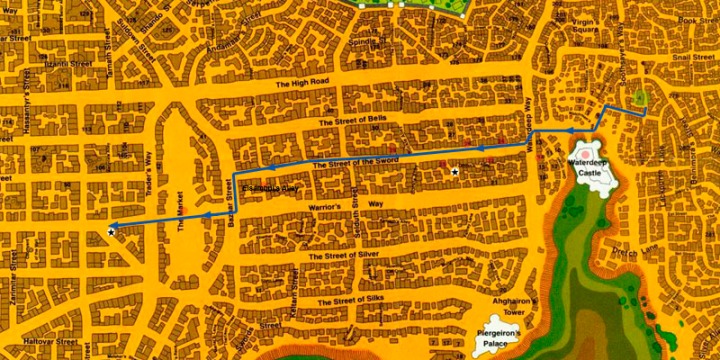
“Heading north from the Yawning Portal, you first cross over Soothsayer’s Way and end up in front of the stately and grand Castle Waterdeep. Built into the very mountain, it is a daunting sight that symbolizes the granite will of the Wardhavian people. As you pass by, you notice a few black robed magisters and a dozen watchmen heading up the main rampart into the castle.
As you cross Waterdeep Way, you notice a man carrying dozens of maps and scroll tubes heading west. Continuing up The Street of Swords, you pass by the enormous Elfstone Tavern. The delicious smell of fresh bread signifies The Master Bakers’ Hall, quickly followed by beautiful music coming from Halambar Lutes & Harps, a very soothing store.
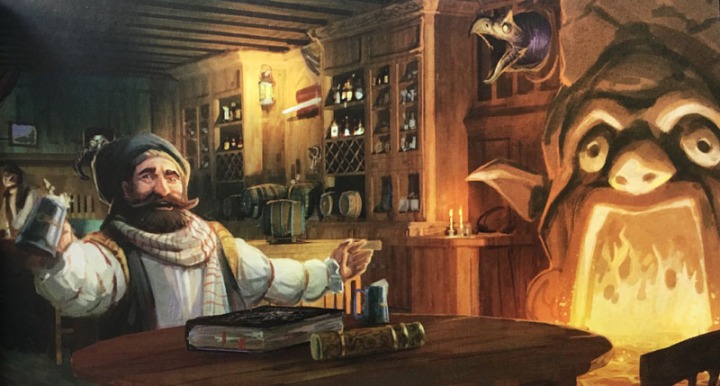
To your left, you can spy what you think is one of the famous Walking Statues, tucked into a nearby alley. It appears to have the head of a hawk or eagle and is leaning forward at an awkward angle. Moving on, you pass the mysterious Crawling Spider, a tavern said to recreate life in the foreboding Underdark, quickly followed by a store with the impressive title, Balthorr’s Rare and Wondrous Treasures. A temple dedicated to the elves is supposed to be nearby, but you did not see it. Near the end of the street, you pass Elsambul’s Alley, infamous for the hundreds of cryptic messages scrawled on its walls. No one has deciphered all its riddles.
Once you cross over Bazaar Street, the entire area opens up into the enormous Market. The single largest area in all of Waterdeep, the place is the size of a large village, and is packed with wall to wall vendors selling everything from apples to zombie talismans and everything in between. There are 100,000 people in Waterdeep and apparently every one of them is shopping here right now. The place is packed with people.

As you make your way through the throng, a halfling runs full speed into you. He bounces off without even slowing, yelling back, “Sorry, Scuse me, gotta go!” and runs off into the crowd. (If the players don’t question you here, tell them afterwards that one of them just got robbed.)
It takes almost an hour to get to the other side of the Market, you realize it would have been faster to walk around. As you continue north up Sul Street, you can see your destination. The God Catcher is one of the famous Walking Statues. This one is a muscular man frozen in a very dramatic pose.
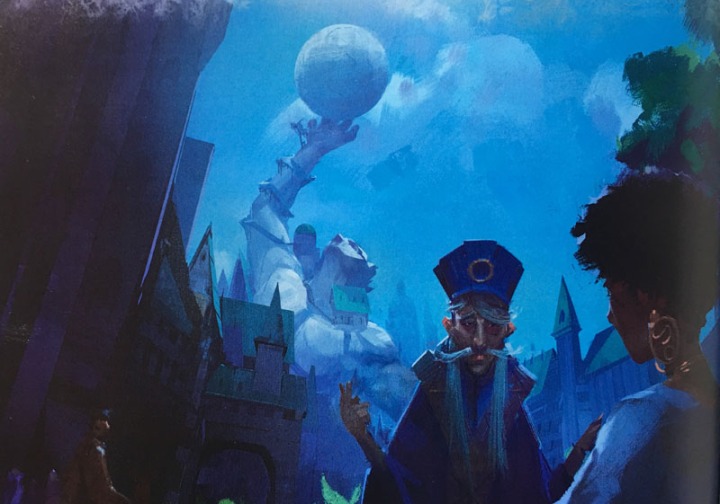
One leg is sunk into the ground and one hand is pushing up from the ground, as if it was trying to rise. The other arm is stretched upward reaching toward a huge marble sphere, magically suspended above it. Its face looks up toward the sphere and it appears to be crying. (This is caused by bird poop.)
Incredibly, people have built houses and towers all over the statue, clinging to the knee, chest and shoulders. A spiral staircase leads up and around the outstretched arm ending at a small house in the palm of his hand. This is where you need to go, to try and speak with the owner, who probably will refuse to see you.”
This may seem like a ton of exposition, but that whole passage, with pauses, can be read in 3 minutes. Just 3 minutes to give your players a vibrant picture of the city, filled with lots of options for your players to explore.

If the players stop you to investigate something you have not prepared for, you can use Volo’s Guide to Waterdeep to improvise a short encounter or you can ask them to hold off investigating it until you have prepared a full encounter for them. For example, if my players really wanted to explore the alley with all the secret code (who wouldn’t), I would play it like this. “As you enter the alley you are overwhelmed by the sheer magnitude of messages. Words, symbols, and images flow all over the walls, the trees, even the ground. They are in multiple languages and none seem to follow a straight line. You’ll have to come back later to truly explore the area. But you do recognize one passage that has the symbol of the Xanathar Guild. It reads, “No deal. Return it to me and I won’t kill you.”” This satisfies the players with a little info related to the main quest and then later you can develop the area further if the players want.
Sometimes, when I have to give the players a lot of exposition, I’ll write out an entire scene to basically read to them. But long bits of story exposition are BORING, so I try to incorporate a mix of location flavor, dialog, and plenty of pauses for the players to react to.
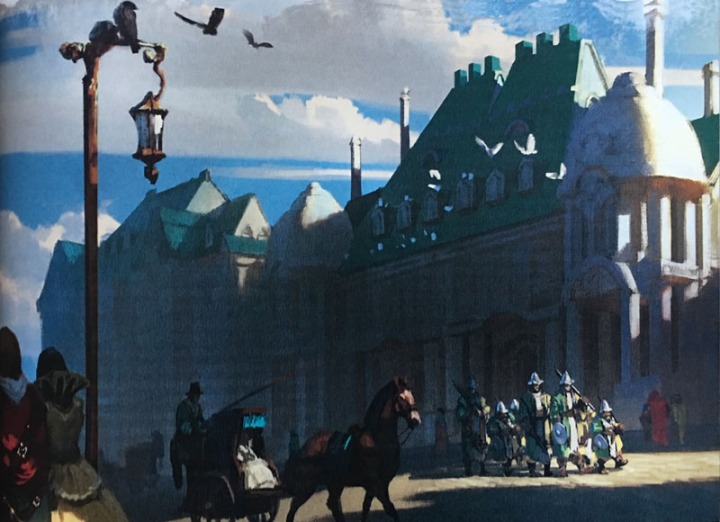
Going back to their encounter with the Blackstaff, I included a lot of area details, including some unusual sounds heard whilst on the Street of Bells and the unique appearance of the Mages’ Guild complex. There was a brief encounter with a deranged Priest of Oghma that foreshadowed the plot of the entire campaign. This was followed by full descriptions and behaviors of all the principles of an upcoming adventure that I based off the novel Blackstaff Tower, which canonically occurs in the year of my campaign, 1479 DR. I’ve included a PDF of this encounter if you are interested. Blackstaff Tower Intro
This also bring us to the next aspect of running a major city; Encounters. There are two new types: Street Encounters and Group Encounters. The random street encounter should be quick, with a simple resolution; a beggar, an accident, a pickpocket, a runaway cart. The best kinds involve two things: a slice of city life and a simple morality choice. Do you give the beggar a coin? Do you help with the accident or ignore it?
Occasionally, there will be a street encounter that involves combat but bear in mind this will almost always bring the town guard to investigate. This will lead to another morality choice. Will the party fight, flee, bribe, or explain?
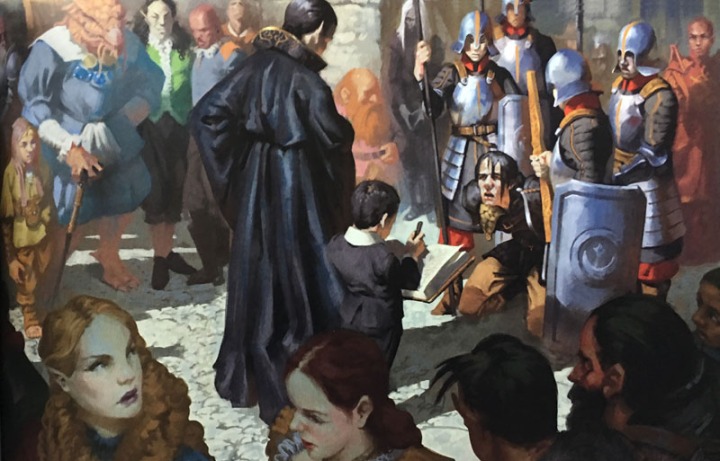
But don’t fall into the trap of making the random encounter the adventure. 95% of the time the random street encounter should only take a few minutes of game time and then move on with the adventure. Very rarely should a “random” encounter be the session, and when they are then it should really be integrated with the story anyway.
The Group Encounter involves when the party needs to meet a large number of people in a very short amount of time. Specifically, I find this useful when trying to integrate the players into the powerful elite factions of the city. This is one of the few times that I will deliberately overwhelm my players with too much information.
The Dragon Heist adventure provides an excellent opportunity to do this with the Guild network in the city. The players become owners of a tavern. Assuming that they want to run a tavern, have the players’ characters spend a few days of “downtime” fixing it up. Then hit ‘em with the guilds.
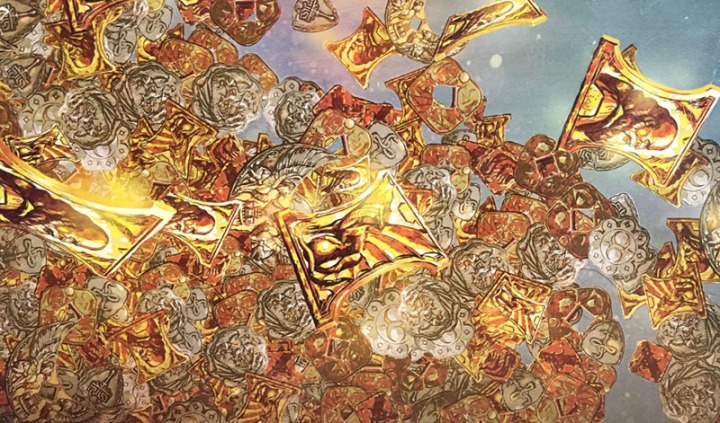
“While you are cleaning up the tavern, there is a knock at the door. “’Allo, and well met friends. It appears that you’re fixin’ up ol’ Trollskull. Well, bein’ new ta town, I’m sure ya didn’t realize that youse need a license fer such tings. Lucky fer youse, I’m da guy ya need ta talk ta. I’m Broxley Fairkettle, Fellowship of Innkeepers.”” A few more lines of dialog, and Broxley closes with, “I’ll send my boy around ta work out the fees and the particulars.”
As soon as that’s done, there’s a new knock. “Opening a tavern, are you? The name’s Hammond Kraddoc, Vintners’, Distillers’, and Brewers’ Guild at your service. You’re gonna need beer, booze and zzar and lots of it. I’ll send my boy around for all the particulars.”
But don’t stop there, keep it up. “Justyn Rassk, Guild of Butchers. You planning on serving food here?” “Elemost Dunblast, Carpenters’, Roofers’, and Plasterers’ Guild. Looks like you got a pretty big hole in your roof.” “Ormbras Delzord, Guild of Chandlers and Lamplighters. It sure gets dark in this alley at night. We can fix that for you.” “Baerhar Surtlan, Pewterer and Casters Guild. You serving ale in mugs or are you drinking it out of your hands?” “JhalossanTurnstone, Cellarers’ and Plumbers’ Guild. I’d hate to see them sewers back up into your establishment.” “Zulgoss Helbeard, Dungsweepers Guild. Be a real shame if someone accidentally left all their garbage out in front of your tavern.”
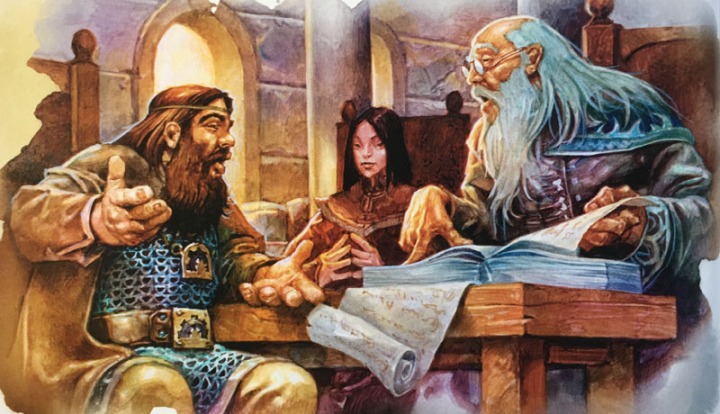
By the way, I ran all these guys like little mobsters. Don’t let the players write anything down. They can ask later if they really need a name. You want the players to feel dizzy after all this. They are part of a huge, bustling metropolis, and it’s not going to stop to let them catch their breath. Later on, any part of the adventure that involves any of them will feel organic and fulfilling since they already have a connection with this otherwise irrelevant NPC.
Another good way to use this is with a party, especially a noble party. In Dragon Heist, the easiest way to do this is to have Raenar Neverember invite them to one as thanks for rescuing him. This allowed me to introduce a whole bunch of important (and unimportant) NPCs, dropped a ton of plot hooks, and presented the city as a vast landscape of adventure. And best yet, it required minimal, yet interesting role play.
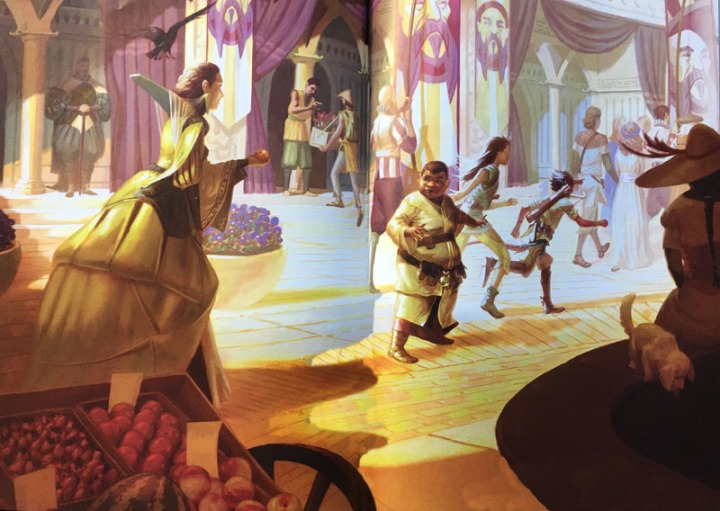
I handed them a lovely invitation which required a player written RSVP. I make everyone buy new clothes which involved finding a fancy clothing shop in the directory. I described the carriage ride to the villa, using the techniques above. At the noble house, I have a few bits of levity, as the grandiloquent butler mispronounces their names. Then I ask how they plan to mingle with crowd; using charm, deception, persuasion, or eavesdrop (sneak).
A few dice rolls later, I hand them a bunch of tidbits, gossip, and overheard rumors that are printed on cards. Then I have the players read them to each other. Every bit of info is relevant to either the group campaign or to an individual player’s downtime activities, but no one had the rumor that was important to their own story. They had to share with the others to get the whole picture.
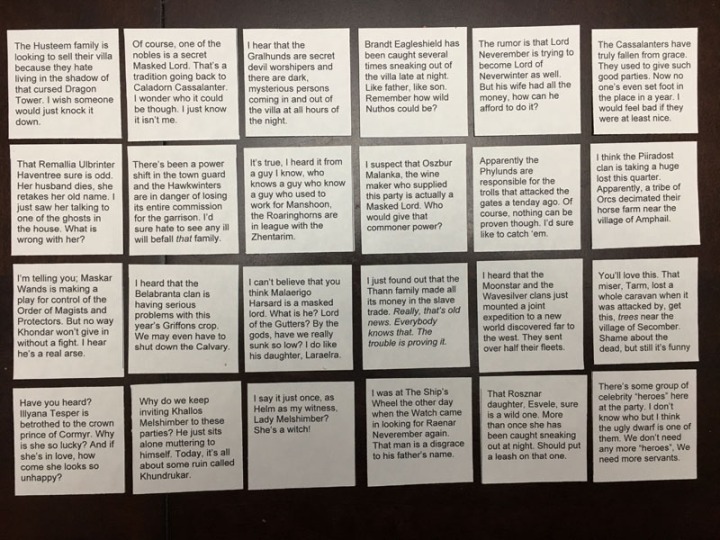
This worked out great. It gave them a little role-play, a couple of new contacts, a lot of town flavor, and a few story hooks. That is what running a city campaign is all about. Presenting the illusion that the players are in a huge sandbox. I don’t develop any of the story ideas I drop until the players tell me which ones they like. There is always some condition that delays acting on what they want to do until next session.
There are more things that you can do to enrich your city. You could add weather to your storytelling. Create elaborate random encounter tables. The list is endless. But I hope that these suggestions will help make running a city like Waterdeep a little easier. If you have any questions, issues, or ideas, leave a comment and I will address it.
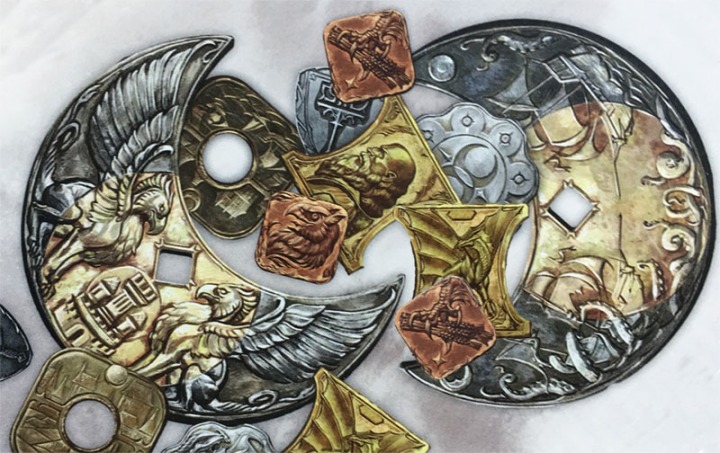
For more detail about running a fantasy city, specifically Waterdeep during the Dragon Heist adventure, check out my Waterdeep Dragon Heist Resources Page.
As always, may your purse be ever full of dragons, and Game On!
Folk shall know of Waterdeep, Our City of Splendors, and sign its praises, – Ahghairon, first Open Lord of Waterdeep, 1032DR

Reblogged this on DDOCentral.
LikeLike